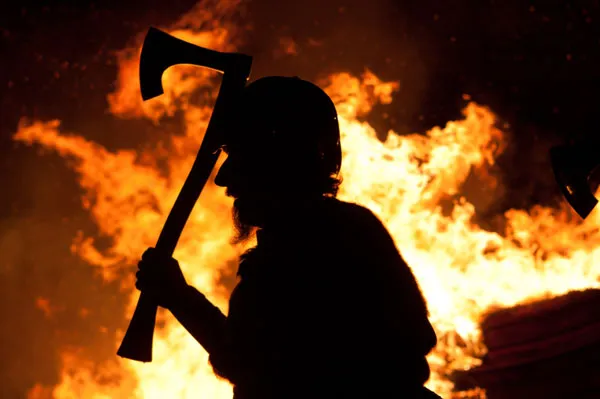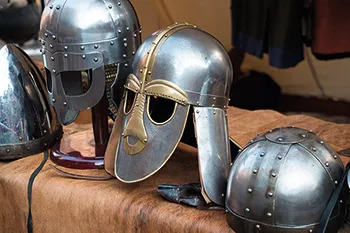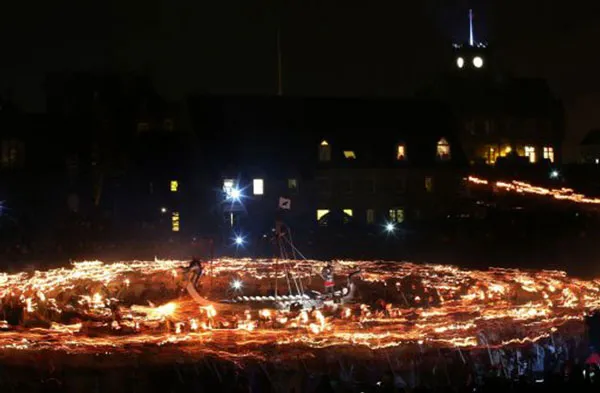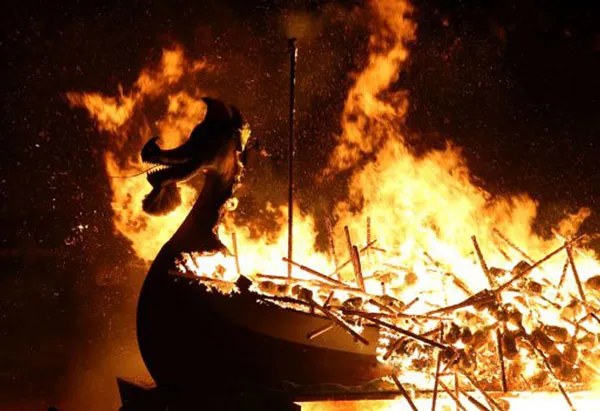Of all the Kings of England, only two merit the title ‘Great’. One is Alfred of the burnt cakes – the Saxon monarch who successfully stopped the Viking conquest of all England. The other, much less famous, is Cnut – himself a Viking, and best known for failing to turn back the tide at his command. But since we are marking the millennium of Cnut’s coronation this year, we should rediscover the monarch who achieved more than getting his feet wet.
Cnut (also known as Canute) was more than just an English king. He reigned over a North Sea empire embracing Denmark, Norway, and parts of Sweden too. And though a savage warrior in true Viking style – he mutilated a group of hostages by blinding them, hacking their hands off and leaving them on the beach at Sandwich to starve – Cnut left behind a positive legacy of trade, stability and prosperity that was sadly squandered by his squabbling sons.
If it hadn’t been for that, we Brits would be a very different people today. We would probably speak a Scandinavian tongue, drive Volvo cars, and watch gloomy films about madness and marital infidelity to pass away the long winter nights.
Bloodthirsty Behaviour
So what were Cnut’s Viking people – who colonised northern and eastern England, Scotland and Ireland for centuries – really like? The reputation of these rugged warriors who sailed the seas and roamed the known world from America to Russia for rapine, butchery and looting was so terrifying that traumatised victims prayed God to spare them “from the fury of the Northmen” and such Viking tortures as the ‘Blood Eagle’ in which a victim’s chest was torn open, his ribs spread and his heart and lungs ripped out.

In AD 793, a Viking war party raided the Holy Island of Lindisfarne off the coast of Northumberland, murdering the monks who had made the island a centre of early Christianity in Britain. From then on, the dread sight of the square-sailed Viking longboats heading over the horizon struck sheer quaking fear into Britain’s early inhabitants. For centuries the Lindisfarne raid set a terrifying template: the Viking longships appeared as if from nowhere, the raiders would wade ashore, murder and mutilate the men they found, rape the women, burn the homesteads and carry off both portable plunder and live hostages to be used as slaves or bargaining chips to raise ransoms.
Despite this terrifying reputation, archaeological discoveries, like the silver coin hoards unearthed by metal detectors, or the bone combs, chessmen, Viking shops and even the fossilised faeces found at the Jorvik Viking Centre in York prove that Viking culture and society was far richer and more complex than their wild warrior image suggests. A fine Viking experience is usually on offer beneath ancient Coppergate in York (the Viking captured the town in 867 and made it their capital, Jorvik) but is sadly closed at present due to the recent flooding. However, London’s British Museum contains a rich repository of Viking artefacts, such as a longship, weapons, treasures and beautiful examples of Viking carving.

The first Viking raid took place on the Holy Island of Lindisfarne in 793AD. The Anglo Saxon Chronicle records:
“In this year were dreadful forewarnings come over the land of Northumbria, and woefully terrified the people: these were amazing sheets of lightning and whirlwinds, and fiery dragons were seen flying in the sky. A great famine soon followed these signs, and shortly after in the same year, on the sixth day before the ides of January, the woeful inroads of heathen men destroyed God’s church in Lindisfarne island by fierce robbery and slaughter”
Marauders to Settlers
Starting with the Orkney and Shetland islands closest to their own native lands, the Vikings began bringing their families across the North Sea, settling to form colonies – such as Dublin, Strathclyde and the Isle of Man – in the lands they had ravaged with their hit-and-run raids. The Viking legacy in Shetland is especially rich, ranging from the Up Helly Aa fire festival in the capital Lerwick, in which a model Viking galley boat is spectacularly set in flames, to remains of Viking villages.
In Scotland, Govan Old Church in Glasgow contains 31 intricately carved Viking stones, the work of those who ruled the Viking kingdom of Strathclyde between the 9th and 11th centuries. The Braaid on the Isle of Man consists of two Viking longhouses excavated in 1942 and 1964. The longhouses, both nearly 20m long, were where Vikings and their livestock lived in close proximity.
Viking-ruled north and eastern England – Mercia, Northumbria and Anglia – became known as the Danelaw. Today the Viking legacy lingers there not only in the genes of many northerners, but linguistically in the endings of place names such as ‘thorpe’, the Viking word for a hamlet. By 871, when King Alfred came to the throne of the Saxon heartland of Wessex, the Vikings were bidding fair to occupy the whole of England.
Resistance and Revenge
Alfred the Great miraculously turned back the seemingly inevitable Viking conquest of southern England, forcing their leader, Guthrum, to convert to Christianity and make a compromise peace with the Treaty of Wedmore in 878. A century later, however, under the inept rule of Aethelred the Unready (‘unready’ meaning ill-advised rather than unprepared), Aethelred’s policy of trying to buy the Vikings off with tribute bribes known as ‘Danegeld’ failed. Aethelred treacherously ordered a general massacre of the Danes centred on Oxford in 1002. One of the victims was Gunhilde, sister of Sweyn Forkbeard, King of Denmark. In 2008, the skeletons of 37 male victims of the slaughter were unearthed at St John’s College – all bearing the marks of their violent deaths.

The annual Up Helly Aa fire festival in Shetland, in which a Viking-style galley boat is set alight. Picture: ©Andrew Milligan / PA Wire/Press Association Image
Incensed, Sweyn invaded England with his teenage son Cnut and chased Aethelred into exile. On his father’s death in 1016, Cnut defeated Aethelred’s successor Edmund Ironside at the Battle of Assundune in Essex and ruled over his Scandinavian empire until his own death in 1035. He died and was buried in Alfred’s former capital Winchester. By 1042, his direct line had died out.
The year 1066 is best remembered for the Norman Conquest. But if history’s dice had rolled in a different direction, it could easily have meant the Viking Conquest. On the childless Edward the Confessor’s death in January, there were three claimants to England’s crown: Harold Godwinson, head of Saxon England’s most powerful noble family, and chosen by the Saxon council, the Witan, to be their king; Duke William of Normandy, who swore he had been promised the crown by both Edward and Harold; and the Viking claimant King Harald Hardrada of Norway, a giant of a man supported by Harold Godwinson’s renegade brother Tostig.
Hardrada moved first. In the very last Viking invasion of England, his longships with 8,000 men crossed the North Sea, and glided up the River Ouse to York, defeating the local Saxon Earls, Edwin and Morcar at Fulford as he did so. In London, Harold Godwinson gathered an army and marched north. He caught up with Hardrada and Tostig at Stamford Bridge, east of York, and smashed them, killing both.
The rest, as they say, is history. Duke William’s victory over Harold’s exhausted Saxon army at Hastings a few weeks later meant that Britain became a French-influenced European state and the English language evolved into a mix of Latin and Norse. The Viking legacy became one more, if highly coloured, thread in the rich tapestry of Britain’s tangled past.

SEE BRITAIN’S VIKINGS
Up Helly Aa, Shetland www.uphellyaa.org
The Govan Stones, Glasgow www.thegovanstones.org.uk
The Braaid, Isle of Man www.isleofmanguide.com
Jorvick Viking Centre, York www.jorvik-viking-centre.co.uk
British Museum, London www.britishmuseum.org
Nigel Jones is a historian, journalist and author. He guides visits to historical sites in the UK and Europe for Historical Trips, the tours company he co-founded in 2010. A father of three, he lives in Sussex. www.historicaltrips.com